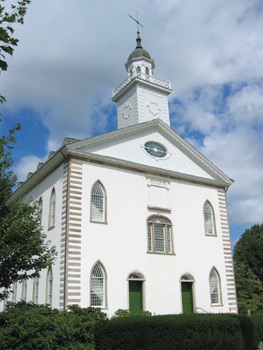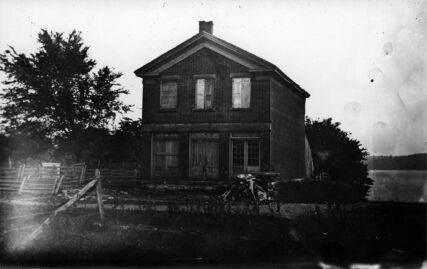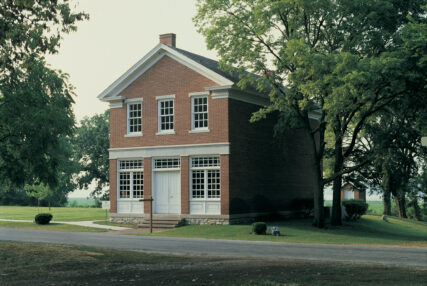(RNS) — Many people were stunned by the news earlier this month that the Church of Jesus Christ of Latter-day Saints had purchased several key historic buildings in Ohio and Nauvoo, Illinois, from Community of Christ, the second-largest Latter-day Saints denomination, which was, until 2001, called the Reorganized Church of Jesus Christ of Latter Day Saints.
Chief among these properties was the Kirtland Temple, built by early members of the church in the mid-1830s while they settled in northern Ohio before continuing their westward migration.
After announcement of the sale, many people raised questions about what changes the LDS Church might make to the temple and what the popular tours of the site would be like going forward. In Salt Lake City last week, I sat down with Matt Grow, managing director of the Church History Department, to get answers. This interview has been edited for length and clarity. – JKR
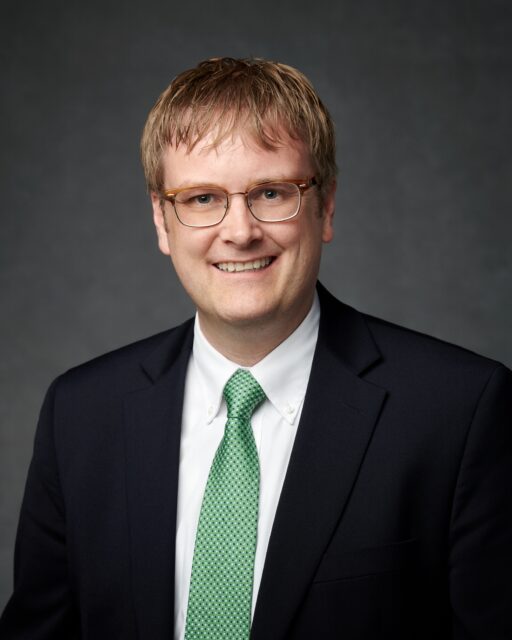
Matt Grow, managing director of the Church History Department of the Church of Jesus Christ of Latter-day Saints. Photo courtesy of Matt Grow.
This is a time of deep mourning for my friends who are in Community of Christ because of the long history they have invested in the building.
Yeah, very mixed feelings. I think for us there are three primary emotions in recent weeks. The first, of course, is excitement. We’re excited because we love the history; we love these artifacts and buildings. The second is a deep sense of responsibility and of sacred trust. And the third is a recognition of how difficult this is for some of our friends in Community of Christ. The Book of Mormon calls us to mourn with those who mourn, and we recognize the sadness that many of them feel over these events. We’ve tried to do everything we can to make it a good process to validate those feelings and to help them know that the temple is going to remain accessible, including for special Community of Christ events.
Tell me more about that.
There is an agreement that Community of Christ can hold special events in the Kirtland Temple or in the Nauvoo buildings, a cumulative six special events a year. We’re committed to working with them to make sure that they have those opportunities for continued great experiences in the temple. Over the past decades they have given access to the temple to so many Latter-day Saints, and we want to be good stewards and ensure that they will have that same access.
Yes, they opened the building to everyone. I got to preach from the pulpit at the Kirtland Temple, and got to go up to the top and stand out on the cupola. I’m very afraid of heights, but I was not gonna miss that! I’m so glad I did because I can’t really imagine that’s going to be on the LDS tour going forward.
That’s pretty remarkable. Well, probably not.
What will the tour look like? There is a concern it might be cast as a missionary opportunity.
The tour will be led by missionaries — young sister missionaries and senior missionaries — but they have had training in both the history and in how to give a tour. Which is a different skillset than teaching the missionary discussions or knocking on doors. We are confident in their abilities to give excellent tours.
The tour will begin in the Visitors Center where you have a great view of the temple. And then it will take you through all three levels of the temple — the ground floor, the second floor, and the attic area. We will cap the tours at about 25 people because at this point, we feel like we can have 25 people safely in the attic.
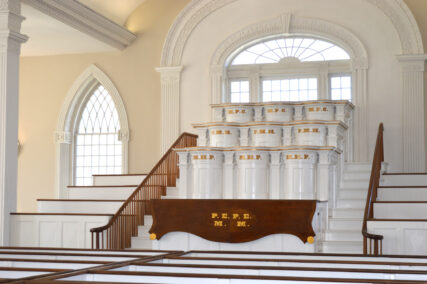
The interior of the first floor of the Kirtland Temple. ©2024 by Intellectual Reserve, Inc. All rights reserved.
Our tours do talk to some extent about the building structure and architecture. But fundamentally, we’re most interested in what happened to the people in the temple. We focus on 1836, the high point of the dedication of the temple. And then for Latter-day Saints, the spiritual manifestations that happened after the temple dedication.
So, for example, the focus of the attic will be about a vision that Joseph Smith had that’s now in Section 137 of the Doctrine and Covenants. In the vision he sees his brother Alvin, who was deceased, and his parents who were still alive, all in the Celestial Kingdom together. It’s a really important vision in developing clarity about Latter-day Saint doctrines of the afterlife.
When are the new tours going into effect?
Monday morning, March 25. We closed the building for 20 days. We were able to bring in a small group of historians and writers about six weeks before the announcement to prepare new tours. We have a new tour in Kirtland, as well as another new tour at the Red Brick Store in Nauvoo, and one at the Mansion House and the Homestead in Nauvoo. So, three new tours for us.
As soon as the announcement was made, we had the tours ready. We began training the missionaries the very next day because it’s a tight turnaround.
What kind of work is being done to preserve the temple?
Our approach is going to be one of prudence and patience. We’re going to go slowly and carefully, because we need to learn a lot about the building. Our goal will be to do whatever is necessary on the Kirtland Temple to make sure it stands another 200 years.
I wouldn’t expect a closure in the coming months. There’ll be some time as we learn everything and get it ready. But at some point, work will need to be done on it. One of the amazing things about the Kirtland Temple is that significant work was never done to it. Right? You walk in that temple and you’re walking back to the 1830s. There was never a time when an elevator was added, or a wing was added. So we’ll just work to make sure that it’ll be stable.
- A mid-1880s photo of the original Red Brick Store. Courtesy Church of Jesus Christ of Latter-day Saints
- The reconstructed Red Brick Store in Nauvoo, built in 1980 to replace the original building, which was torn down in 1890. Courtesy Church of Jesus Christ of Latter-day Saints
What will be happening with the properties you’ve acquired in Nauvoo?
One is a property called the Smith Family Homestead. That was an existing building when the Latter-day Saints moved to Nauvoo, basically as religious refugees. Joseph and Emma moved into this existing building and lived there from 1839 to 1843. His parents lived with them for some time, and his younger sister. So it was busy, and was not a particularly large home. From there, they moved to the Mansion House in August, 1843. It was a much larger home, and it was intended to be a hotel as well. On the tour, these homes allow us to talk about Joseph and Emma’s private life.
The homes were also used for various public functions. The bodies of Joseph and Hyrum lay in state there after their death. We’ll also talk about how those homes received many visitors. We’ll tell the story in the Mansion House of Jane Manning James arriving to the home, and Emma inviting her in just as they would’ve received white visitors. Jane Manning was a free Black woman who had just walked 800 miles from Connecticut to Nauvoo. Joseph invited Jane, as the leader of the little group who had arrived with her, to tell her story. And then he commented afterwards to John Bernhisel, “Have you ever seen such great faith?”
So we’re always looking for ways to tell the stories of not just Joseph and Emma, but others in the Nauvoo community.
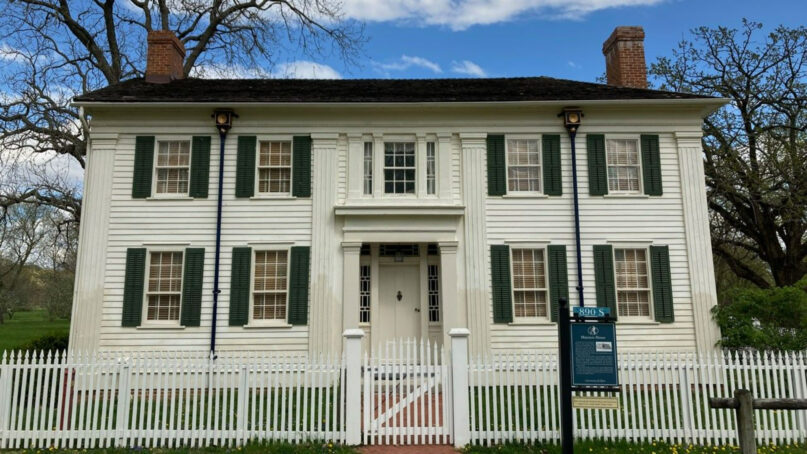
The Mansion House in Nauvoo, where Joseph and Emma Smith moved in 1843. ©2024 by Intellectual Reserve, Inc. All rights reserved.
As part of that tour, we will also walk by the Nauvoo House, which was a really significant building at the time. In 1841, the Lord commanded them to build the temple. In that same section of the Doctrine and Covenants, they’re commanded to build the Nauvoo House, a large boarding house where people could come and learn about Zion. It was to house about 300 people.
So you have two very large public works projects going on in Nauvoo for the next several years, the temple and the Nauvoo House. The people have got to raise the funds for both. Eventually, particularly after Joseph Smith’s death, they have to prioritize one of the buildings. They stop work on the Nauvoo House and prioritize work on the temple, and the Nauvoo House is never finished.
In 1871, Emma Smith’s second husband, Lewis Bidamon, takes this partially built structure and makes it into what’s called the Riverside Mansion, where Emma will live the last eight years of her life. So when we say we bought the Nauvoo House, it’s that reconstructed Riverside Mansion, the successor to the Nauvoo House. Community of Christ, I think, has used both names.
Maybe eight or nine years ago, I went to a fantastic retreat in Nauvoo, and it was held in that building. It was a powerful experience to get to spend the night in a place Emma had lived for years. Will the LDS Church use it for retreats as well?
We don’t yet know quite how we’re going to use the building — if there will be those sorts of events there or whether it would be appropriate to have a For the Strength of Youth conference there. Those are all decisions for the future.
Related content:
Kirtland Temple purchased by LDS Church for $192.5 million
Polygamy, politics, and frontier justice: Why Nauvoo still matters
